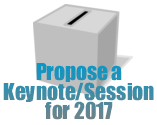Follow NEMC
openUWEDAT – The Freedom to Process Any Environmental Observation in the Most Natural Way
Oral Presentation
Prepared by B. Božić, G. Dünnebeil
Austrian Institute of Technology GmbH, Donau-City-Strasse 1, Vienna, , 1210, Austria
Contact Information: Bojan.Bozic@ait.ac.at; +436642351800
ABSTRACT
Environmental data can often be simplified to the following structure: One measurement like ozone concentration and some status information like “temperature too high”, or “UV-lamp defect”. The measurement is usually coded as a float value, while status can be represented in one or more integers. However, recent projects, especially in the field of correlating traffic and environmental data, required a different view: The measurement was not a simple value, neither was the resulting time series sampled at a fixed interval. The most natural way to measure vehicle flows is to record each one and tag them with a timestamp.
In order to meet this challenge, AIT created openUWEDAT, a whole new software architecture for acquiring, storing, and calculating time-series, which allows irregular intervals, as well as completely free definitions of measurements, ranging from classical floats or integers to arrays or even string values. This allows users to model measurement processes in the most natural way. In order to handle this degree of freedom, the architecture relies on a well-defined interface (TimeSeries API) with interchangeable operators, which are user-definable and can be plugged in during run time. Operators can aggregate measurements to simple mean values, or build high level indicators like the Air Quality Index. It is also possible to correlate traffic data to particulate matter or black carbon.
Another highlight is its sensor level plug and play capability, where new devices are recognized and configured at runtime. Apart from collecting measurements from such devices, the system creates user definable processing pipes, which aggregate values and publish them to interested consumers, like a database, viewer, or simply another time series processor.
This architecture will be described in the following paper. It will not go into details, but introduce its components and how they fit together, including a few examples.
Oral Presentation
Prepared by B. Božić, G. Dünnebeil
Austrian Institute of Technology GmbH, Donau-City-Strasse 1, Vienna, , 1210, Austria
Contact Information: Bojan.Bozic@ait.ac.at; +436642351800
ABSTRACT
Environmental data can often be simplified to the following structure: One measurement like ozone concentration and some status information like “temperature too high”, or “UV-lamp defect”. The measurement is usually coded as a float value, while status can be represented in one or more integers. However, recent projects, especially in the field of correlating traffic and environmental data, required a different view: The measurement was not a simple value, neither was the resulting time series sampled at a fixed interval. The most natural way to measure vehicle flows is to record each one and tag them with a timestamp.
In order to meet this challenge, AIT created openUWEDAT, a whole new software architecture for acquiring, storing, and calculating time-series, which allows irregular intervals, as well as completely free definitions of measurements, ranging from classical floats or integers to arrays or even string values. This allows users to model measurement processes in the most natural way. In order to handle this degree of freedom, the architecture relies on a well-defined interface (TimeSeries API) with interchangeable operators, which are user-definable and can be plugged in during run time. Operators can aggregate measurements to simple mean values, or build high level indicators like the Air Quality Index. It is also possible to correlate traffic data to particulate matter or black carbon.
Another highlight is its sensor level plug and play capability, where new devices are recognized and configured at runtime. Apart from collecting measurements from such devices, the system creates user definable processing pipes, which aggregate values and publish them to interested consumers, like a database, viewer, or simply another time series processor.
This architecture will be described in the following paper. It will not go into details, but introduce its components and how they fit together, including a few examples.


